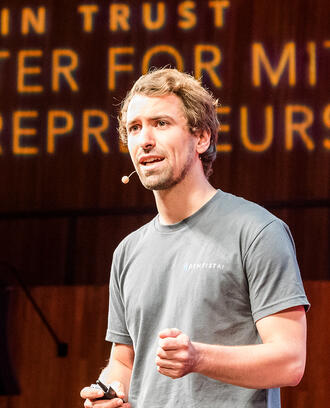Ideas Made to Matter
How an MIT scholar is creating an 'army of entrepreneurs'
By
When Rajesh Nair, professor of practice at the Asia School of Business, thinks about an inflection point in his life, he thinks of the radio repair shop in his Indian village of Chirayinkil, and the repairman who showed the 10-year-old Nair that there were not, in fact, tiny people living and singing inside the device.
“That is the power of intervention,” Nair, SDM ’14, said, and it is at the heart of his 8-year study about to begin, which will measure the benefits of introducing maker skills to thousands of Indian middle and high school students.
“I want to create a program that creates a whole army of entrepreneurs in India,” said Nair, who is also an MIT visiting scholar on product design, commercialization, and entrepreneurship. “Entrepreneurship is primarily your mindset. It’s not just about business plans and funding, it’s about the ability to see a problem as an opportunity and taking the risk to maximize the returns.”
Nair plans to study the impact of maker lab experiences on students in 6th-12th grade. A 6-month pilot version is scheduled to start in August, within 60 schools in India. The study is funded by the Asian Development Bank.
“There’s a lot of studies done on when someone says they want to be an entrepreneur, and then what kind of thinking do they have to do to build up to a large company,” Nair said. “But there is very little study on kids who’ve never been exposed [to entrepreneurship]. How do you bring them to a point of aspiring to be an entrepreneur?”
Threshold of fear
Nair’s idea for the study stems from his research as an MIT Tata Center fellow (he’s an alumnus of the center’s first class).
During his time with the center in 2012-14, Nair traveled to India for his thesis work. What he found was that there were problems all across the country, but they were the same problems in different villages. Someone in each of these communities had figured out a way to solve their problem — like using a motorcycle engine for power in a place without electricity — and five miles down the road at the next village, that same problem had been solved in another way by someone else.
“There were all these little islands of innovation that were never pulled together to reach a large market potential,” Nair said. “What was missing is an entrepreneur who could see all these opportunities from a larger point of view, and create something — a company, a business, to serve a wider market.”
Those entrepreneurs were missing, Nair explained, because often in Indian culture, families and communities are not primarily concerned with children living up to potential, but more focused on their living a stable life with a stable job, without the fear of failure. That fear is the external force pushing back on potential innovators, he said.
“How do you break that limit,” Nair said. “The core of the problem is how do you make people break past their threshold of fear.”
Drawing on his own experience as a curious boy in a radio repair shop, and from research and feedback on the best ways to teach and learn, Nair traveled with a mobile maker lab to colleges in India, Malaysia, Vietnam, and the United States, to test out his hypothesis of the potential impact of such intervention on students.
Creating role models
In 2017, the Indian government decided to put money behind a similar idea, and reached out to Nair — who’d made connections during his time as a Tata fellow — for help putting together maker labs for thousands of schools through a program called Atal Tinkering Labs.
“The maker part is where you can dream, imagine, and create,” Nair said. “It really doesn’t have to be solving a problem, but it has to be fun.”
Nair ran a 48-hour Tinkerfest program in 12 schools in New Delhi, in which the students were given a problem such as “make an annoying toy.”
“How do you break it down into the physical parts, how do you break it down into electronics, how do you write code, make the behavior,” Nair said. “Now we are breaking the product from how it acts with the user to how it’s constructed, so the students learn CAD [computer-aided design], 3D printing to make mechanical parts, create motions, light, sound, then they wrote the software to make the behavior happen.”
Students with no exposure to electrical engineering or software skills could pick up the basics in two days, Nair said, because they were learning in an exploratory environment and solving a problem through the creative process.
An 8-year study
The Indian government last year opened maker labs in 2,441 schools and plans to double that number this year. The goal is to reach 60,000 schools in four years, Nair said.
And while these maker labs are growing, Nair is going to be studying their impact on students and the overarching communities where they live. With the help of the maker lab instructors, Nair will gather information on things like student attendance, interest in subjects, innovation skills, entrepreneurial attitudes, and community engagement — to see what happens to students who are exposed to this type of learning, compared to those who don’t get that experience.
“If you really want to create entrepreneurs you really have to start them as makers, and build them up to innovators,” Nair said. “A good ecosystem is primarily a good ecosystem because of role models that others can emulate. How do you insert role models that these kids can grow up to be? Someone who has gone out and started a company suddenly becomes a role model for the community around you and it has a vicarious impact. The driving force is creation of role models.”



